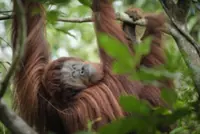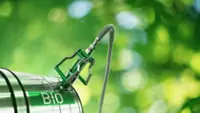A Javan gibbon swings from tree to tree in the forest of Kampung Cimaranginan in Lengkong Village, Sukabumi, West Java, on Nov 7, 2020. - Photo: kompas.com file
JAKARTA: An expedition team has found a thriving population of the endangered owa jawa (Javan gibbon) in the forests of Mount Sanggabuana in West Java, recording a total of 311 individuals.
Bernard T Wahyu Wiryanta, the expedition’s leader, said on Tuesday (Oct 1) that the team had documented a total of 107 groups of Javan gibbon and that the majority were juveniles, with some still being carried by females.
The Sanggabuana Owa Jawa Expedition Team started its 40-day research period on July 31, with two groups combing the forest, hills and pathways in the 16,500-hectare mountain area.
Bernard said the findings showed the Javan gibbons on Mount Sanggabuana were reproducing well.
“In one of the sections of the forest, we would wake up at 5 a.m. in our basecamp in the middle of the forest to the singing of owa jawa from all over the forest,” he told kompas.com.
The Javan gibbon is one of West Java’s endemic primates and is protected under Environment and Forestry Ministerial Regulation No. 106/2018.
It is classified as endangered on the International Union for Conservation of Nature (IUCN) Red List of Threatened Species and is considered at high risk of extinction because of the illegal pet trade, hunting, habitat loss and forest fragmentation throughout its range in the provinces of Banten, West Java and Central Java.
It has been previously estimated that less than 4,000 Javan gibbons remain in the wild.
Despite the expedition’s encouraging findings, Bernard underlined that the threats of poaching and deforestation remained in the Sanggabuana area.
A significant portion of hunting activity in the area supplies young animals for the pet trade, according to IUCN.
Javan gibbons can tolerate a disturbed habitat, but they are known to prefer lush patches of forest as their diet consists mainly of fruit and leaves, and, to a lesser degree, flowers and insects.
The expedition was held by the Sanggabuana Conservation Foundation (SCF) with the support of Astra Otoparts Group.
Bernard said the findings of the expedition would be used by the SCF and delivered to the government as a reference in deciding the next steps for the Javan gibbon conservation programme.
He said it was crucial to rehabilitate severed corridors of forest and add trees to support the population.
Vitriana, a conservation official with the West Java Natural Resources Conservation Agency (BBKSDA), said Mount Sanggabuana had an important role as a natural habitat of the endangered species.
“As such, the area has to be supervised to support the life and sustainability of owa jawa as endemic primates of Java,” she said. - The Jakarta Post/ANN





